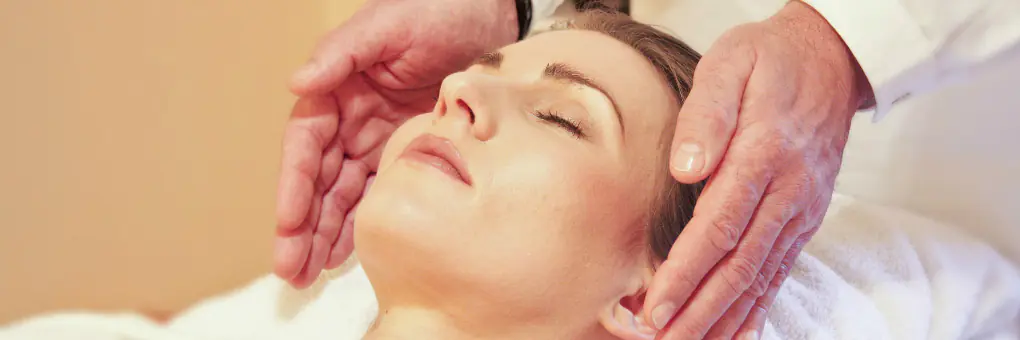
Does neodymium laser rejuvenation help? What aesthetic problems does it best solve? How should you prepare for the procedure?
We will consider these and other questions in the article.
How does a neodymium laser work?
The active element of the device, which ensures its main action, is neodymium metal ions enclosed in yttrium-aluminum garnet. Like any other lasers, the rays of a neodymium device are absorbed not by the entire skin, but by certain of its structures - collagen and elastin fibers.
The main layer of our skin, the dermis, can be figuratively described as a “water spring mattress.” Water, or more precisely, a liquid-saturated gel, is hyaluronic acid. It does not allow the covers to wrinkle and retains moisture. “Springs” are collagen and elastin fibers. They, located in the dermis in the form of columns, arches and inclined elements, provide elasticity, firmness and tone of the integumentary tissue. When there are enough of them, there are no wrinkles on the face, the integument does not slide down under the influence of gravity, and the nasolabial and eyebrow folds do not deepen.
It is these fibers of the skin frame that are affected by the neodymium laser. It destroys old “springs” and at the same time deeply warms the skin. Heat activates dormant fibroblast cells. They “wake up” and synthesize new scaffold fibers, as well as hyaluronic acid - the water “filler” of the skin tissue.
Effects of neodymium laser rejuvenation
All women who underwent the procedure noted in the next 2-3 hours after it:
- improvement of complexion;
- return of radiance to the face;
- reduction of gravitational ptosis and wrinkles;
- narrowing of skin pores;
- erasing spider veins;
- hair removal for blonde hair.
If neodymium rejuvenation is supplemented by the influence of an alexandrite laser (the Elite+ device allows this), then the effects become much greater:
- pigment spots are erased;
- dark circles under the eyes go away;
- dark hair stops growing if the area above the upper lip is worked.
Indications
Rejuvenation using a neodymium laser will help solve the following problems:
- photoaging;
- unhealthy complexion;
- medium and small expression wrinkles;
- drooping skin;
- loss of skin radiance.
The procedure performed with the Elite+ laser has additional indications:
- acne;
- dark spots;
- noticeable hair (above the upper lip, in the chin area);
- hirsutism;
- spider veins or spots;
- excessively wide skin pores.
Preparing for neodymium rejuvenation
There is no need to prepare for the procedure. You can eat as usual, sunbathe, and take the necessary medications.
How is the procedure performed?
Neodymium laser rejuvenation is carried out in several stages:
- Cleansing the skin from mechanical impurities.
- Treatment of covers with an antiseptic.
- Applying an anesthetic cream, the purpose of which is to numb the upcoming procedure.
- Wearing safety glasses.
- Laser exposure to skin.
The whole procedure lasts about 10-15 minutes.
Benefits of neodymium laser rejuvenation
The procedure performed with the Elite+ laser has the following undoubted advantages:
- painless;
- performed in a short period of time;
- does not require long recovery;
- solves a large number of aesthetic problems at once in one session;
- can be performed on tanning.
Recovery after the procedure
The first 2-3 hours after neodymium rejuvenation, the skin looks reddened - just like after any other thermal procedure or massage. After this time, the redness goes away, and the effect described above becomes noticeable.
Consequences of neodymium rejuvenation
The procedure has no complications. Unlike “regular” laser rejuvenation, the skin is not injured, but only warmed up. Consequently, no microholes are formed on it, which could become an entry point for infection. There is also no need to “drop out” from society or take a vacation: the redness will go away in a few hours.
Contraindications
Unfortunately, exposure to a neodymium laser has its contraindications. This:
- diabetes;
- tumor diseases;
- pregnancy;
- lactation;
- tuberculosis.
Thus, neodymium laser rejuvenation is an effective and painless procedure that does not require preparation or long-term rehabilitation!
Laser therapy has long been successfully used in modern cosmetology. Laser-based devices are constantly being improved, which explains the great popularity of procedures based on them. Particularly in demand is a solid-state laser emitter, the design of which is based on a yttrium aluminum garnet crystal. The yttrium aluminum garnet crystal is activated by neodymium ions. Neodymium is a rare chemical element, a silver-white metal with a golden tint. A distinctive feature of this type of laser is its intensity, power and length of light, which is capable of penetrating to a depth of 6-8 mm into tissue. Neodymium laser is successfully used in surgery, urology, gynecology, and in the treatment of malignant diseases, as it is able to coagulate blood vessels and reduce bleeding during surgery.
Operating principle of a neodymium laser
A neodymium laser is a hardware installation that is capable of producing a stream of laser radiation with different wavelengths, such as a minimum of 532 nm, 585 nm, 650, and a maximum of 1064 nm. This type of radiation promotes various methods of facial skin rejuvenation and increases the effectiveness of laser hardware techniques. What are the capabilities of a neodymium laser?
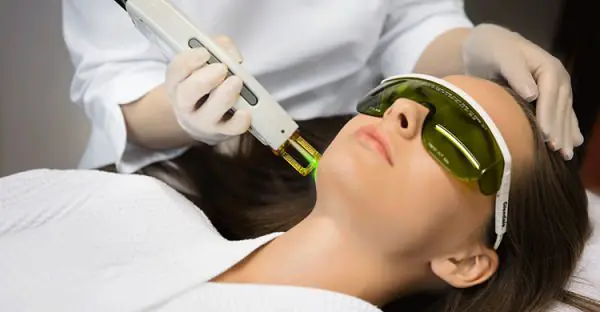
With it you can:
- rejuvenate the skin;
- treat acne;
- perform hair removal;
- remove spider veins;
- eliminate traces of post-acne;
- eliminate age spots;
- remove tattoos;
- make scars, scars and stretch marks on the body less noticeable.
The hair removal procedure using a neodymium laser consists of several stages.
The first stage is to prepare the skin for laser treatment. This stage also includes a consultation with a specialist aimed at identifying and eliminating all contraindications. Contraindications most often include acute, chronic and infectious diseases of internal organs and systems, pregnancy and lactation.
The second stage begins with applying an anesthetic drug in the form of a cream or spray to the intended treatment area. Then the hair removal procedure itself begins. The specialist selects the optimal laser cone feeding mode for each case and directs it to the desired area. The procedure lasts approximately 30 minutes.
The number of procedures usually includes six sessions with an interval of about a month. After laser exposure, the skin turns slightly red and goes away on its own within 3 days.
The advantages of neodymium laser hair removal include the fact that its effect is not aimed at destroying melanin, but at the vessels that nourish the follicles. As a result of light exposure on the blood vessels, they stick together and stop feeding the follicle, which leads to its death. Since the neodymium laser does not interact with the pigment, this type of laser can be used on red and blond hair. And the depth of penetration of light radiation allows you to eliminate even those follicles that are deep under the skin.
Spider vein removal
Neodymium laser has the property of coagulating capillaries and leading to their degradation. We can say that the procedure for removing telangiectasia (spider veins) using a neodymium laser is the most comfortable. Comfort is created by a multi-phase cooling system that automatically applies to the treated area. Anesthesia is also administered before the procedure, which also makes the procedure painless. Hemangiomas and the initial stages of rosacea are removed in the same way.
Improvement structures scar tissue
After exposure to a neodymium laser on scars, they become smoother and more elastic. Due to vascular coagulation, scar tissue becomes paler and less noticeable on the skin. To improve scar tissue and achieve better results, laser therapy should be used in conjunction with laser resurfacing.
Neodymium laser is also capable of rejuvenating facial skin. Improved blood circulation leads to the activation of fibroblasts and the growth of young cells that synthesize the “youth” proteins collagen and elastin. The new collagen has a strong, ordered fiber structure, which allows you to create a new framework for the skin, improve the contour of the face and tighten it in the chin area. Small wrinkles and deep folds also undergo metamorphosis: the former are completely smoothed out, and the latter become less noticeable. As a result, the face looks fresh, young and healthy, without wrinkles, unevenness and stagnant spots.
Eliminating traces post-acne neodymium laser
Acne leaves behind unsightly scars on the face, which can cause serious psychological suffering for their owners. Nowadays, this problem can be successfully eliminated. In this case, it is the use of a neodymium laser device that guarantees incredible precision, penetration of the laser beam of light to the required depth and obtaining results that are impossible when using any other laser system. Why is this so?
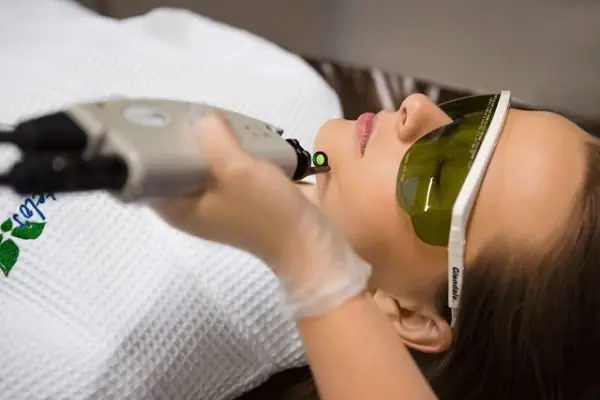
When working with a device based on a neodymium laser, photomodification of scar tissue occurs, which makes the skin smooth and even. Normalization of blood circulation in the capillaries ensures the disappearance of pigmented and stagnant spots left after acne, which remain for a long time at the site of the broken abscess.
Elimination of pigment spots
The neodymium laser activates metabolic processes in the skin, enhances photocoagulation of capillaries, which makes it possible to effectively destroy melanocytes. As a result, stagnant pigment spots disappear, skin tone improves, the face becomes whiter, and its structure becomes uniform.
Neodymium radiation of a certain wavelength can destroy red, orange, green, blue and yellow tattoo dyes in skin tissue. But professionally executed tattoos made with special equipment are especially successfully removed. This way the dyes under the skin are distributed evenly at a shallow depth. The situation is worse with tattoos made by amateurs, which cause injuries to the skin and penetration of dyes to a fairly large depth.
Advantages of neodymium laser
The advantages of this type of laser are as follows:
- A variety of light pulse lengths allows us to develop an individual approach depending on the characteristics of each patient’s skin.
- The neodymium laser acts in a targeted manner, carefully treating the desired areas.
- This type of laser is equipped with a cooling system that has several levels and allows you to make any procedure comfortable and safe.
- The laser cooling system prevents heating of the surface layers of the skin and prevents thermal burns.
- The dual system of switching the device from one type of activity to another allows you to carry out procedures of different directions without changing the nozzle during one session.
- Control over the physical characteristics of the emitted light (number of pulses, energy density, wavelength) allows you to strictly match the characteristics of the patient’s phototype. In addition, the physical characteristics remain unchanged throughout the session.
- Devices based on neodymium laser completely eliminate the risk of side effects and complications.

Indications for the procedure
Indications for the procedure are:
- the whole spectrum of age-related skin aging;
- hyperpigmentation;
- scars and post-acne scars;
- scars, stretch marks;
- presence of tattoos;
- removal of unwanted hair;
- telangiectasia (spider veins).
Contraindications to the procedure
The procedure has the following contraindications:
- pregnancy and lactation;
- autoimmune and oncological diseases;
- acute and chronic diseases;
- infectious diseases;
- dermatological diseases and herpes;
- skin coagulation disorder;
- fresh tan
The use of neodymium laser in cosmetology has improved methods of skin rejuvenation and getting rid of many cosmetic defects.

Facial and body rejuvenation procedures have reached a new level. Now you don't need surgery to look 5-6 years younger. To do this, you just need to undergo several laser skin treatment procedures. However, today there is a large selection of devices and procedures themselves, patients are lost and do not know what to choose. In our article we will look at the two most popular techniques. Photorejuvenation or laser rejuvenation, which is better?
How does photorejuvenation work?
The essence of this rejuvenation method is based on the action of a special cosmetology device that creates a light beam of a certain frequency. The specialist independently adjusts the wavelength of radiation, depending on the condition of the patient’s skin.
There are several methods and types of photorejuvenation. The doctor selects individually which device can best cope with the patient’s skin problems.
- Laser photorejuvenation is considered one of the most effective; a neodymium laser is used here.
- IPL – this technique uses fairly intense pulses of light. The skin is exposed to frequent flashes of radiation of a given intensity.
- Elos photo-rejuvenation - a device is used here that combines electro- and photo-rejuvenation of the face; it emits light of electrical origin.
- Collagen photorejuvenation is performed using collagen lamps. Unlike elos-rejuvenation, they affect the skin with light rays of a certain length.
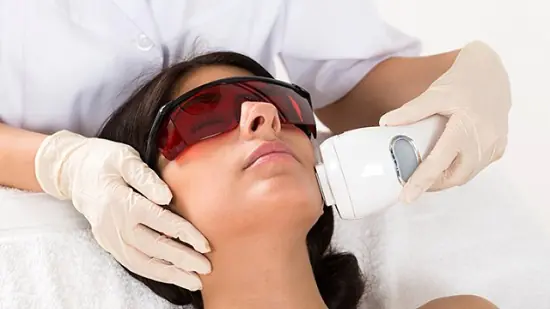
Photorejuvenation helps patients with various skin problems. Indications for this type of rejuvenation include:
- dark spots;
- expression wrinkles;
- gray skin tone;
- signs of skin aging: sagging, sagging tissue, the appearance of jowls and a double chin;
- rosacea;
- enlarged and contaminated pores;
- increased skin oiliness.
The photorejuvenation procedure takes place in several stages. In order for the patient to be calm and know what will be done with him, it is worth knowing in advance how this type of rejuvenation is carried out.
1. Cleansing the skin and applying gel for cooling and better contact between the skin and the light pulse;
2. The patient wears special glasses to protect his eyes;
3. The rejuvenation procedure itself begins, the specialist applies the device to the treatment area and a photo flash is fired, with rays of a certain length. So the doctor goes around each area on the face. The procedure itself lasts from 15 to 60 minutes, depending on the area being treated.
4. At the end of the session, the doctor treats the skin with an anti-inflammatory and hypoallergenic gel, which helps soothe the skin and maintain the effect of the procedure.
As a rule, redness is visible on the skin immediately after the procedure. However, it goes away after a few hours. Thus, the rehabilitation period after each procedure is quite short. But visible changes can be noticed within 10-14 days after the first visit to the doctor. According to patient reviews, they noticed that, unlike conventional anti-aging procedures, after the first visit to photorejuvenation, the skin becomes smoother, tightened, and small wrinkles are smoothed out. The doctor decides how many photorejuvenation sessions are required. He assesses the condition of the skin, looks at the reaction after the procedures and calculates how many visits will be necessary. Plus, the patient himself notices a significant difference in the condition of his skin.
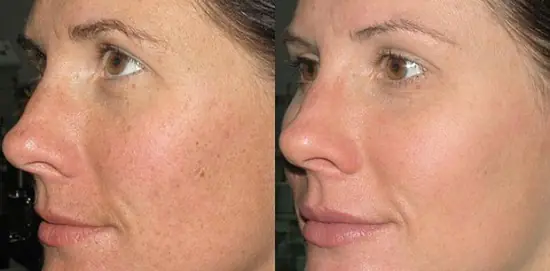
Each patient should familiarize themselves with the contraindications before undergoing one or another photorejuvenation procedure. And inform your doctor about their presence. So, photorejuvenation is not performed when:
- the presence of tumors in the body;
- hypertension;
- pregnancy;
- blood diseases;
- inflammatory processes on the skin;
- diabetes mellitus;
- presence of pacemakers;
- diseases of the thyroid gland.
Laser rejuvenation: what is it?
Modern developments by scientists in the field of skin rejuvenation have made it possible to make a big breakthrough. Rejuvenation is becoming safer and faster, as evidenced by the results of laser rejuvenation procedures using a fractional CO2 laser.
The essence of this technique is selective influence. The beams form a laser lattice, the radiation evaporates small areas of the skin. Each of the finest rays creates a depression, a fraction, in the skin to a certain depth. There is a uniform alternation of evaporated zones with untouched ones. In turn, the areas that remain untouched have a healing effect on the damaged areas. By contracting and regenerating, they create a good lifting effect.
There are several varieties of this procedure. Laser rejuvenation can be performed using two methods:
— Ablative rejuvenation is a targeted laser effect that evaporates the upper cells of the epidermis, penetrating a maximum of 1.5 mm under the skin. During the procedure, superficial areas of the skin are removed. This method is best suited for the first signs of aging.
- Non-ablative rejuvenation - this method, on the contrary, has a deeper effect on the skin. The beam can penetrate to a depth of 5 mm. Thus, the laser helps cells build a new membrane framework and renew themselves from the inside. All processes are activated, the production of collagen and elastin. This solves the problems of skin aging and visible changes, tightens the oval of the face and improves skin color. The skin receives maximum healing and rejuvenating effect, both from the inside and outside.
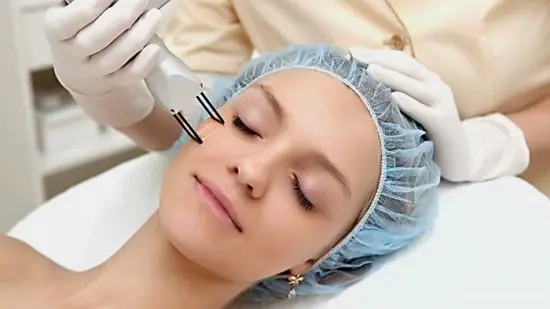
Indications for laser facial rejuvenation include:
- acne and post-acne;
- significant photoaging of the skin;
- deep expression wrinkles;
- poor skin condition;
- sagging and sagging;
- pigmentation;
- enlarged pores.
The whole procedure is divided into several important stages, which should include:
1. Makeup removal and pain relief in areas of particular sensitivity.
2. After 20 minutes, when the skin is no longer sensitive, the doctor begins laser treatment. The session can last up to 60 minutes. The exact amount of time depends on the scope of work and zones.
3. After laser treatment, the doctor applies products with dexpanthenol to the skin for speedy healing and tissue restoration. In the first two hours after the procedure, swelling, pain and redness are observed in the treated areas.
Redness and swelling may persist for 2 days. Next, crusts will appear on the skin; they can last from 3 to 10 days, depending on the depth of the effect. Experts recommend lubricating the skin well with soothing agents: Bepanten, Panthenol, D-panthenol, as well as creams with hyaluronic acid. In 2-3 weeks the scabs will disappear and you can sign up for a new procedure.
Typically, a laser rejuvenation course consists of 3-5 sessions, depending on the problems the patient has addressed. Three months after the last procedure, the maximum rejuvenation effect can be observed. To maintain results, it is recommended to undergo 1-2 preventive procedures per year. Which will help against rapid skin aging and give minus 5-6 years.
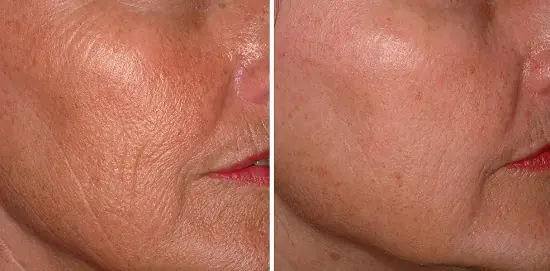
Laser rejuvenation is considered the most gentle method, there are no side effects, and the rehabilitation period lasts only 7-10 days. Despite the accessibility and effectiveness of the procedure, anyone who wants to undergo laser rejuvenation should first familiarize themselves with the contraindications and be sure to notify the doctor about the presence of any ailments before starting the procedures.
So, laser rejuvenation is not recommended for:
- open skin diseases, including herpes;
- psoriasis, dermatosis;
- the presence of infections in the body;
- wounds at the treatment site;
- pregnancy and breastfeeding;
- immune diseases;
- diabetes mellitus;
- ischemic disease.
Photorejuvenation or laser rejuvenation: which is better?
Let's summarize what to choose for rejuvenation: photo procedures or laser?
Photorejuvenation is suitable for patients aged 30 to 55 years. Ideally copes with age spots, dilated blood vessels and pores. Also good for removing fine and superficial wrinkles.
In contrast, laser rejuvenation is suitable for patients over 45-50 years old. Because laser copes better with deeper skin rejuvenation and has a pronounced lifting effect. Fractional CO2 lasers help remove moderate to deep expression lines.
Such procedures can easily replace both plastic surgery and other methods of rejuvenation and facelift.
However, to accurately determine which procedure is right for you, it is best to consult with a cosmetologist. At the Lazmed Clinic, both rejuvenation methods are used; our highly qualified doctors will be able to choose the best rejuvenation method for the individual characteristics of the skin.
Video of laser rejuvenation procedure at the Lazmed clinic



